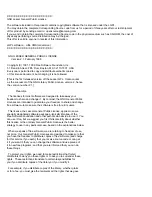
Chapter 3: Applications and Configuration Overview
Avidia System Configuration and Management User Manual
27
•
Configure the FRF.5 or FRF.8 circuit for each port. This includes creating the cross connect
through the Avidia system (from the line card to the IDSL frame card), and configuring cell
loss priority, congestion control, and the traffic type. The available traffic types are:
–
ubr (Unspecified Bit Rate)—This is a best-effort class of traffic that is best suited for
a LAN. When network congestion occurs, the data is stored in a buffer until it can be
sent.
–
cbr (Constant Bit Rate)—This traffic class carries a guaranteed constant bandwidth. It
is best suited for applications that require fixed bandwidth, such as uncompressed
voice, video, and circuit emulation. CBR is a Quality of Service class defined by the
ATM Forum for ATM network.
–
nrt-vbr (non-real-time Variable Bit Rate)—This traffic class carries variable
bandwidth. It is well suited for data services such as frame relay over ATM which
requires guaranteed bandwidth and lower Quality of Service. It is not well suited for
LAN traffic due to the unpredictability of LAN traffic burst size.
–
rt-vbr (real-time Variable Bit Rate)—This traffic class carries a variable bandwidth. It
is well suited for real-time services such as compressed voice and video which require
stringent cell transfer latency and less bursty traffic. It is not well suited for LAN traffic
due to the unpredictability of LAN traffic burst size.
•
Configure a session to set the service and encapsulation types for the cross connect. The
available encapsulation types depend upon the service type you select and both must match
the modem encapsulation type. See
“Configuring Bridging and Routing Sessions” on
(command-line interface) or
Summary of Contents for AVIDIA SWD4573I1
Page 6: ...Summary of Changes for Version 2 0 vi Avidia System Configuration and Management User Manual...
Page 26: ...Table of Contents xxvi Avidia System Configuration and Management User Manual...
Page 28: ...2 Avidia System Configuration and Management User Manual...
Page 36: ...Management Tools and Protocols 10 Avidia System Configuration and Management User Manual...
Page 44: ...Next Steps 18 Avidia System Configuration and Management User Manual...
Page 102: ...Saving Configurations 76 Avidia System Configuration and Management User Manual...
Page 104: ...78 Avidia System Configuration and Management User Manual...
Page 166: ...Configuring xDSL Subscriber Names 140 Avidia System Configuration and Management User Manual...
Page 230: ...Configuring ATM Policing 204 Avidia System Configuration and Management User Manual...
Page 302: ...Monitoring IDSL Current Performance 276 Avidia System Configuration and Management User Manual...
Page 396: ...370 Avidia System Configuration and Management User Manual...
Page 438: ...Configuring IDSL Service 412 Avidia System Configuration and Management User Manual...
Page 440: ...Configuring IDSL Service 414 Avidia System Configuration and Management User Manual...
Page 452: ...Configuring DS3 Service 426 Avidia System Configuration and Management User Manual...
Page 492: ...Configuring ATM Policing 466 Avidia System Configuration and Management User Manual...
Page 582: ...Monitoring IDSL Alarm Status 556 Avidia System Configuration and Management User Manual...
Page 618: ...Activating and Deactivating Ports 592 Avidia System Configuration and Management User Manual...
Page 620: ...594 Avidia System Configuration and Management User Manual...
Page 628: ...Setting the System Date and Time 602 Avidia System Configuration and Management User Manual...
Page 636: ...610 Avidia System Configuration and Management User Manual...
Page 642: ...Glossary 616 Avidia System Configuration and Management User Manual...
Page 657: ......
















































